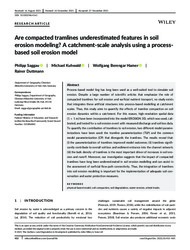Are compacted tramlines underestimated features in soil erosion modeling? A catchment‐scale analysis using a process‐based soil erosion model
DOI: https://doi.org/10.1002/ldr.4161
Persistent URL: http://resolver.sub.uni-goettingen.de/purl?gldocs-11858/9796
Persistent URL: http://resolver.sub.uni-goettingen.de/purl?gldocs-11858/9796
Supplement: https://doi.org/10.5281/zenodo.5153427
Saggau, Philipp; Kuhwald, Michael; Hamer, Wolfgang Berengar; Duttmann, Rainer, 2021: Are compacted tramlines underestimated features in soil erosion modeling? A catchment‐scale analysis using a process‐based soil erosion model. In: Land Degradation & Development, Band 33, 3: 452 - 469, DOI: 10.1002/ldr.4161.
 |
Dokument öffnen: |
Process‐based model ling has long been used as a well‐suited tool to simulate soil erosion. Despite a large number of scientific articles that emphasize the role of compacted tramlines for soil erosion and surficial nutrient transport, no study exists that integrates these artificial structures into process‐based modelling at catchment scales. Thus, this study aims to quantify the effects of tramline compaction on soil erosion dynamics within a catchment. For this reason, high‐resolution spatial data (1 × 1 m) have been incorporated into the model EROSION 3D, which was used, calibrated, and tested for a soil erosion event with measured discharge and soil loss data. To quantify the contribution of tramlines to soil erosion, two different model parameterizations have been used: the tramline parameterization (TLP) and the common model parameterization (CP) that disregards the tramlines. The results reveal that: (i) the parameterization of tramlines improved model outcomes; (ii) tramlines significantly contribute to overall soil loss and sediment entrance into the channel network; (iii) the bulk density of tramlines is the most important driver of increases in soil erosion and runoff. Moreover, our investigation suggests that the impact of compacted tramlines have long been underestimated in soil erosion modelling and can assist in the assessment of surficial flow path connectivity. Thus, the integration of tramlines into soil erosion modeling is important for the implementation of adequate soil conservation and water protection measures.
Statistik:
ZugriffsstatistikSammlung:
This is an open access article under the terms of the Creative Commons Attribution‐NonCommercial‐NoDerivs License, which permits use and distribution in any medium, provided the original work is properly cited, the use is non‐commercial and no modifications or adaptations are made.

